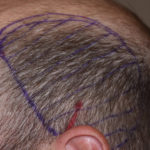Background: The shape of the head is influenced by five different surfaces. These consist of the front, back, sides (2) and the top. Each surface has an effect on the appearance of the overall head shape. While there is specific numerical numbers that define the ideal head shape, there are certain convexities and shapes to it that make it either appealing or unaesthetic.
The shape of the side of the head is rarely thought unless it has some abnormal shape to it. The side of the head, also known as the posterior temporal region, can be seen as unaesthetic if it is too wide (increased convexity) or is too narrow. (no convexity) By far the more common concern is one of too much convexity which creates the ‘lightbulb’ appearance. This is where it is wide high above the ear and then becomes more narrow as it gets closer to the ear.
The posterior temporal region is composed of five layers. These consists of the skin, subcutaneous fat, fascia, temporal muscle and bone. While all layers make a contribution to its thickness, the muscle represents a more significant component than most think.



Head narrowing is done by muscle removal and not bone removal. There are no functional deficits created by removal of the entire posterior temporal muscle. (limitation of jaw motion or even creation of jaw stiffness)
Highlights:
- The posterior temporal muscle makes up a significant thickness of the side of the head.
- An overly convex side of the head can be reduced by posterior temporal muscle excision.
- Side of the head reduction (head narrowing) can be done in most cases by a hidden incision behind the ear.
Dr. Barry Eppley
Indianapolis, Indiana


